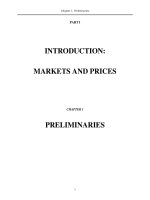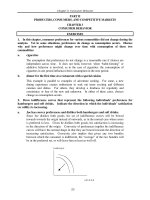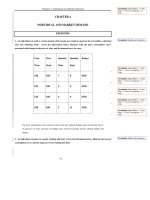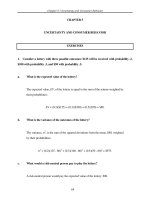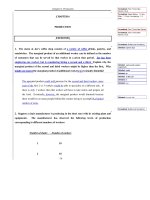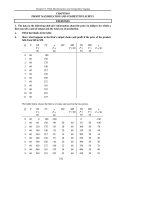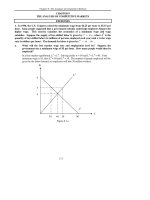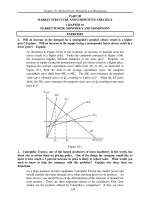Tài liệu Bài tập về Kinh tế vĩ mô bằng tiếng Anh - Chương 14 docx
Bạn đang xem bản rút gọn của tài liệu. Xem và tải ngay bản đầy đủ của tài liệu tại đây (107.31 KB, 15 trang )
Chapter 14: Markets for Factor Inputs
232
CHAPTER 14
MARKETS FOR FACTOR INPUTS
EXERCISES
1. Suppose that the wage rate is $16 per hour, and the price of the product is $2. Values
for output and labor are in units per hour.
q L
0 0
20 1
35 2
47 3
57 4
65 5
70 6
Chapter 14: Markets for Factor Inputs
233
a.
Find the profit-maximizing quantity of labor.
From the information given above, calculate the marginal product of labor, the
extra output produced by hiring one more unit of labor, and then multiply by price
to get the marginal revenue product of labor. To find the profit-maximizing
quantity of labor, use the rule that the firm wants to hire labor only as long as the
marginal revenue product of labor is greater than the nominal wage, or up to the
point where the marginal revenue product of labor is equal to the nominal wage.
From the table below, the firm will hire 5 units of labor.
q L MP
L
MRP
L
0 0 - -
20 1 20 40
35 2 15 30
47 3 12 24
57 4 10 20
65 5 8 16
70 6 5 10
Chapter 14: Markets for Factor Inputs
234
b.
Suppose that the price of the product remains at $2 but that the wage rate increases
to $21. Find the new profit-maximizing quantity of labor.
The above table does not change for this part of the problem. However, the firm
no longer wants to hire 5 units of labor because the benefit of the 5
th
unit ($16 per
hour) is less than the cost of the 5
th
unit ($21 per hour). The firm would only
hire 3 units of labor per hour since in this case the benefit still exceeds the cost at
the margin. The firm would stick with 3 units instead of 4 unless fractional units
are possible. At L=4 the cost is greater than the benefit so you lose profit by
hiring the 4
th
unit of labor.
c. Suppose the price of the product increases to $3 and the wage remains at $16 per
hour. Find the new profit-maximizing quantity of labor.
A change in the price of the product will not change the marginal product of
labor, but it will change the marginal revenue product of labor. The new
marginal revenue product of labor is given in the table below. The firm will still
want to hire 5 units of labor, as in part a above. It will not hire the 6
th
unit
because the extra benefit is less than the extra cost. Profit will be greater than in
part a.
q L MP
L
MRP
L
0 0 - -
20 1 20 60
35 2 15 45
Chapter 14: Markets for Factor Inputs
235
47 3 12 36
57 4 10 30
65 5 8 24
70 6 5 15
d. Suppose that the price of the product remains at $2 and the wage remains at $16,
but there is a technological breakthrough that increases output by 25% for any
given level of labor. Find the new profit-maximizing quantity of labor.
The technological breakthrough changes the number of units of output produced
by a given number of units of labor, and hence changes the marginal product and
the marginal revenue product of labor. The new output values are found by
multiplying the old values by 1.25. This new information is given in the table
below. The firm will still choose to hire 5 units of labor. Profit will be greater
than in part a.
q L MP
L
MRP
L
0 0 - -
25 1 25 50
Chapter 14: Markets for Factor Inputs
236
43.75 2 18.75 37.5
58.75 3 15 30
71.25 4 12.5 25
81.25 5 10 20
87.5 6 6.25 12.5
2. Assume that workers whose incomes are less than $10,000 currently pay no federal
income taxes. Suppose a new government program guarantees each worker $5,000, whether
or not he or she earns any income. For all earned income up to $10,000, the worker must
pay a 50-percent tax. Draw the budget line facing the workers under this new program.
How is the program likely to affect the labor supply curve of workers?
The budget line for workers under this program is a straight line at $5,000. This
line is shown in the figure and table below. Workers earn $5,000 whether they
work or not. If workers work only to earn income, i.e., there are no other benefits
such as “getting out of the house” or “gaining experience,” there is no incentive to
work under the new program. Only wages yielding incomes greater than $10,000
will result in a positive labor supply.
Chapter 14: Markets for Factor Inputs
Income
Thousands of Hours per Year
$10,000
$5,000
Figure 14.2
Income After Tax
Income
Government
Subsidy
Total
Income
0 0 5,000 $5,000
$
1
,
000 500 4
,
500 5
,
000
2
,
000 1
,
000 4
,
000 5
,
000
3
,
000 1
,
500 3
,
500 5
,
000
4
,
000 2
,
000 3
,
000 5
,
000
5,000 2,500 2,500 5,000
6
,
000 3
,
000 2
,
000 5
,
000
7
,
000 3
,
500 1
,
500 5
,
000
237
Chapter 14: Markets for Factor Inputs
238
8,000 4,000 1,000 5,000
9,000 4,500 500 5,000
10,000 5,000 0 5,000
3. Using your knowledge of marginal revenue product, explain the following:
a. A famous tennis star is paid $100,000 for appearing in a 30-second television
commercial. The actor who plays his doubles partner is paid $500.
Marginal revenue product of labor, MRP
L
, is equal to marginal revenue from an
incremental unit of output multiplied by the marginal product from an incremental
unit of labor, or in other words, the extra revenue generated by having the tennis
star appear in the ad. The famous tennis star is able to help increase revenues far
more than the actor, so he is paid much more than the actor. The wage of the actor
is determined by the supply and demand of actors willing to play tennis with tennis
stars.
b. The president of an ailing savings and loan is paid not to stay in his job for the last two
years of his contract.
The marginal revenue product of the president of the ailing savings and loan is
likely to be negative and therefore, the savings and loan is better off by paying the
president not to show up. They have calculated that they will lose less (or gain
more) by paying the president off and hiring someone else.
c. A jumbo jet carrying 400 passengers is priced higher than a 250-passenger model
even though both aircraft cost the same to manufacture.
Chapter 14: Markets for Factor Inputs
239
The ability of the larger jet to generate more revenue increases its value to the
airline, and therefore the airline is willing to pay more for it.
4. The demands for the factors of production listed below have increased. What can you
conclude about changes in the demand for the related consumer goods? If demands for the
consumer goods remain unchanged, what other explanation is there for an increase in
derived demands for these items?
a. Computer memory chips
In general, an increase in the demand for a good increases the demand for its factor
inputs. The converse is not necessarily true; i.e., an increase in the demand for
factor inputs does not necessarily imply an increase in the demand for the final
product. The demand for an input may increase due to a change in the use of other
inputs in the production process. As the price of another input increases, its
demand falls and the demand of substitutable inputs rises. In this case, the
increase in the demand for computer memory chips must have been caused by an
increase in the demand for personal computers given that computer memory chips
are used only in computers, and there are no substitutes for computer memory chips.
b. Jet fuel for passenger planes
With an increase in the demand for jet travel, the demand for jet fuel will increase.
There are no substitutes for jet fuel.
c. Paper used for newsprint
Given the paper is being used to print newspapers then there must have been an
increase in the circulation of newspapers.
Chapter 14: Markets for Factor Inputs
240
d. Aluminum used for beverage cans
With an increase in demand for cold drinks in the summer, the seasonal demand for
aluminum increases, so this is one possible explanation. Alternatively, if glass or
plastic have become more expensive then this may affect the demand for aluminum.
Finally, changes in the market for recycled aluminum may affect the demand for
new aluminum.
5. Suppose there are two groups of workers, unionized and nonunionized. Congress passes
a law that requires all workers to join the union. What do you expect to happen to the wage
rates of formerly nonunionized workers? of those workers who were originally unionized?
What have you assumed about the union’s behavior?
In general, we expect that nonunionized workers are earning lower wages than
unionized workers. If all workers are forced to join the union, it would be
reasonable to expect that the nonunionized workers will now receive higher wages
and the unionized workers will receive a wage that could go either way. There are
a couple of items to consider. First, the union now has more monopoly power in
that there are no nonunion workers to act as substitutes for union workers. This
gives more power to the union, which means higher wages can in general be
negotiated. However, the union now has more members to satisfy. If wages are
kept at a high level, there will be fewer jobs, and hence some previously
nonunionized workers may end up with no job. The union may wish to trade off
some of the wage for a guarantee of more jobs. The average income of all workers
will rise if labor demand is inelastic and will fall if labor demand is elastic.
Chapter 14: Markets for Factor Inputs
6. Suppose a firm’s production function is given by Q = 12L - L
2
, for L = 0 to 6, where L is
labor input per day and Q is output per day. Derive and draw the firm’s demand for labor
curve if the firm’s output sells for $10 in a competitive market. How many workers will the
firm hire when the wage rate is $30 per day? $60 per day? (Hint: The marginal product
of labor is 12 - 2L.)
The demand for labor is given by the marginal revenue product of labor. This is
equal to the product of marginal revenue and the marginal product of labor: MRP
L
=
(MR)(MP
L
). In a competitive market, price is equal to marginal revenue, so MR =
10. We are given MP
L
= 12 - 2L (the slope of the production function).
Wage
Labor
20
40
60
80
100
120
1.5
3.0
4.5
6.0
MRP
L
Figure 14.6
Therefore, the MRP
L
= (10)(12 - 2L). The firm’s profit-maximizing quantity of
labor occurs where MRP
L
= w. If w = 30, then 30 = 120 - 20L at the optimum.
Solving for L yields 4.5 hours per day. Similarly, if w = 60, solving for L yields 3
hours per day.
241
Chapter 14: Markets for Factor Inputs
242
7. The only legal employer of military soldiers in the United States is the federal
government. If the government uses its monopsonistic position, what criteria will it employ
when figuring how many soldiers to recruit? What happens if a mandatory draft is
implemented?
Acting as a monopsonist in hiring soldiers, the federal government would hire
soldiers until the marginal value of the last soldier is equal to his or her pay. There
are two implications of the government’s monopsony power: fewer soldiers are
hired, and they are paid less than their marginal product. When a mandatory draft
is implemented, even fewer professional soldiers are hired. Wages for volunteer
soldiers fall, pushed down by the fact that wages of the draftees can be very low.
8. The demand for labor by an industry is given by the curve L = 1200 - 10w, where L is the
labor demanded per day and w is the wage rate. The supply curve is given by L = 20w.
What is the equilibrium wage rate and quantity of labor hired? What is the economic rent
earned by workers?
The equilibrium wage rate is determined where quantity of labor supplied is equal
to the quantity of labor demanded:
20w = 1,200 - 10w, or w = $40.
Substituting into either the labor supply or labor demand equations, we find the
equilibrium quantity of labor is 800:
Chapter 14: Markets for Factor Inputs
243
L
S
= (20)(40) = 800,
and
L
D
= 1,200 - (10)(40) = 800.
Economic rent is the summation of the difference between the equilibrium wage
and the wage given by the labor supply curve. Here, it is the area above the labor
supply curve up to L = 800 and below the equilibrium wage. This triangle’s area is
(0.5)(800)($40) = $16,000.
9. This exercise is a continuation of Exercise 8. Suppose now that the only labor available is
controlled by a monopolistic labor union that wishes to maximize the rent earned by union
members. What will be the quantity of labor employed and the wage rate? How does your
answer compare with your answer to Exercise 8? Discuss. (Hint: The union’s marginal
revenue curve is given by L = 1200 - 20w.)
Recall that the monopolist chooses output by setting marginal revenue equal to the
marginal cost of supplying one more unit of output, as opposed to the competitive
firm which chooses output by setting price equal to marginal cost, or in other words
producing where supply intersects demand. The monopolistic labor union acts in
the same way. To maximize rent in this case, the union will choose the number of
workers hired so that the marginal revenue to the union (the additional wages
earned) is equal to the extra cost of inducing the worker to work. This involves
choosing the quantity of labor at the point where the marginal revenue curve crosses
the supply curve of labor. Note that the marginal revenue curve has twice the
slope of the labor demand curve. Marginal revenue is less than the wage, because
when more workers are hired, all workers receive a lower wage.
Setting the marginal revenue curve equal to the supply curve for labor, we find:
Chapter 14: Markets for Factor Inputs
1200 - 20w = 20w, or w* = 30.
At w*, we may determine the number of workers who are willing to work by
substituting w* into the labor supply equation:
L* = (20)(30) = 600.
Therefore, if the union wants to maximize the rent that the union members earn, the
union should limit employment to 600 members.
To determine the wage the members will earn, substitute L* into the labor demand
equation:
600 = 1,200 - 10w, or w = 60.
The total rent the employed union members will receive is equal to:
Rent = (60 - 30)(600) + (0.5)(30)(600) = $27,000.
Notice that the wage is higher and the number of workers employed is lower than in
Exercise (8).
244
q = 8 L
*10. A firm uses a single input, labor, to produce output q according to the production
function . The commodity sells for $150 per unit and the wage rate is $75 per
hour.
a. Find the profit-maximizing quantity of L.
Chapter 14: Markets for Factor Inputs
There are two (equivalent) methods of solving this problem. Most generally,
define the profit function, where revenues and costs are expressed in terms of the
input, calculate the first order necessary condition (the first derivative of the profit
function), and solve for the optimal quantity of the input. Alternatively, use the
rule that the firm will hire labor up until the point where the marginal revenue
product (p*MP
L
) equals the wage rate. Using the first method:
π
=
TR
−
T
C
=
p
q
−
wL
π
= 150*8*L
1
2
− 75L
∂
π
∂L
= 600L
−
1
2
− 75= 0
L
=
64.
b. Find the profit-maximizing quantity of q.
From part a, the profit maximizing quantity of labor is 64 so substitute this
quantity of labor into the production function to find
q = 8L
2
1
= 8* 64 = 64
.
c. What is the maximum profit?
Profit is total revenue minus total cost or
π
=
150*64
−
75*64
=
4800.
d. Suppose now that the firm is taxed $30 per unit of output and the wage rate is
subsidized at a rate of $15 per hour. Assume the firm is a price taker, so that the
price of the product remains at $150. Find the new profit-maximizing levels of L,
q, and profit.
After the $30 tax per unit of output is paid, the firm receives 150-30=$120 per
unit of output sold. This is the relevant price for the profit maximizing decision.
245
Chapter 14: Markets for Factor Inputs
The input cost is now 75-15=$60 per unit labor after the subsidy is received.
The profit maximizing values can be found as in parts a-c above:
π
=
TR
−
TC
=
p
q
−
wL
π
= 120*8* L
1
2
− 60L
∂
π
∂L
= 480L
−
1
2
− 60= 0
L = 64
q = 64
3840.
π
=
e. Now suppose that the firm is required to pay a 20% tax on its profits. Find the
new profit-maximizing levels of L, q, and profit.
The profit maximizing values can be found as in parts a-c above, only here profit
is 80% of total revenue minus total cost.
π
= .8(TR
−
TC)
=
.8(
p
q
−
wL)
π
= .8(150*8*L
1
2
− 75L)
∂
π
∂L
= 480L
−
1
2
− 60= 0
L = 64
q = 64
π
= 3840.
246
